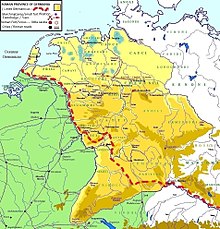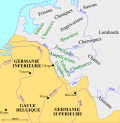Germania Antiqua
| Germania Antiqua Provincia Germania | |
|---|---|
| Provinceof theRoman Empire | |
| 7 BC–AD 9 | |
 The Roman province of Germania (marked in yellow) | |
| Capital | Marktbreit? |
| Historical era | Antiquity |
• Established | 7 BC |
• Disestablished | AD 9 |
| Today part of | |
Germania(also sometimes calledGermania Antiqua[by whom?]) was a short-livedRoman province for the duration of 16 years underAugustus,from 7 BC to AD 9. The possible capital of this province wasMarktbreit(German:Römerlager Marktbreit), acastrum(Roman legionary fortification) with a nearbycanaba(Romanvicus) from the period of EmperorAugustus,located 70 km east of the "Limes Germanicus" on theRiver Main.
History
[edit]The Romans underAugustusbegan to conquer and defeat the peoples of Germania Magna in 12 BC, having thelegati(generals)DrususandTiberiusleading the legions. By AD 6, all of Germania up to theRiver Elbewas temporarily pacified by the Romans as well as being occupied by them, withPublius Quinctilius Varusbeing (unofficially) appointed as Germania's governor.
In 12 BC Nero Claudius Drusus "the elder" crossed the Rhenus to establish Roman control. Many of the Germanic tribes were conquered and by 9 BC he had pushed the border of northern Roman Germania to the Albis (Elbe). Drusus died later that year and was replaced by his brother Tiberius. Tiberius fought a number of smaller wars and eventually left Germania in the hands of various legates who had established friendly relations among the Germans.Augustus, satisfied with the accomplishments of both Drusus and Tiberius, pushed to make Germania Magna (between the Rhenus and Albis) a province of the Roman Empire. The Romans, however, had overestimated their position and found the tribes unwilling to accept the offer of provincial status.In 9 AD under the command of Publius Quinctilius Varus the Romans were caught in a surprise attack while marching through the Teutoburg Forest. The Cherusci tribe, under Arminius (Hermann) destroyed 3 full Legions, the XVII, XVIII, and XIX, resulting in the death of 20,000 Legionaries.[1]
However, the Roman plan to complete the conquest and incorporate all of Magna Germania into the Roman Empire was frustrated when three Roman legions under the command ofVaruswere annihilated by the German tribesmen in theBattle of the Teutoburg Forestin AD 9. Augustus then ordered Roman withdrawal from Magna Germania (completed by AD 16) and established the boundary of the Roman Empire as being theRhineand theDanube.

Under EmperorsVespasianandDomitian,the Roman Empire occupied the region known as theAgri Decumatesbetween the Main, Danube, and Rhine rivers. The region soon became a vital part of theLimes Germanicuswith dozens of Roman forts. The Agri Decumates were finally abandoned to the GermanicAlemanni,after the EmperorProbus' death (282).[2]Some parts of the earlier province were incorporated into eitherGermania InferiororGermania Superiorin AD 85.
InTacitus,Germania AntiquaorGermania Barbara,are synonyms ofGermania Transrhenana,alsoGermania Magna,i.e., the part ofGermaniaon the right side of the Rhine.[3]
See also
[edit]Notes
[edit]Bibliography
[edit]- Carroll, Maureen.Romans, Celts & Germans: the german provinces of Rome.Tempus Series. Publisher Tempus, 2001ISBN0752419129
- Lintott, Andrew.The Cambridge Ancient History: X, The Augustan Empire; 43 B.C. – A.D. 69. 10(2nd ed.). Cambridge University Press. pp. 526–528. Cambridge, 1996ISBN0-521-26430-8.
- Mommsen, Theodore.The Provinces of the Roman Empire.Editor Scribner. New York, 1906

